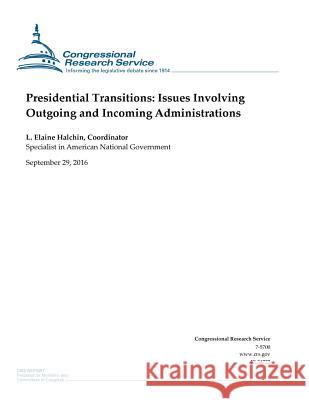Presidential Transitions: Issues Involving Outgoing and Incoming Administrations » książka
Presidential Transitions: Issues Involving Outgoing and Incoming Administrations
ISBN-13: 9781539455370 / Angielski / Miękka / 2016 / 48 str.
Presidential Transitions: Issues Involving Outgoing and Incoming Administrations
ISBN-13: 9781539455370 / Angielski / Miękka / 2016 / 48 str.
(netto: 96,14 VAT: 5%)
Najniższa cena z 30 dni: 100,13
ok. 16-18 dni roboczych
Bez gwarancji dostawy przed świętami
Darmowa dostawa!
The crux of a presidential transition is the transfer of executive power from the incumbent to the President-elect. Yet the transition process encompasses a host of activities, beginning with pre-election planning and continuing through inauguration day. The process ensures that the federal government provides resources to presidential candidates' transition teams, and, eventually, the President-elect's team; and includes close coordination between the outgoing and incoming Administrations. The Presidential Transition Act (PTA) of 1963, as amended, established formal mechanisms to facilitate presidential transitions and authorizes the Administrator of General Services to provide facilities and services to eligible presidential candidates and the President-elect. A presidential transition facilitates the establishment of a new Administration and prepares it to govern. Additionally, as noted by the Senate Committee on Homeland Security and Governmental Affairs in a report on S. 1172 (114th Congress, Presidential Transitions Improvements Act of 2015), planning for a presidential transition helps to ensure the nation's security. The smooth and orderly transfer of power generally is a notable feature of presidential transitions, and a testament to the legitimacy and durability of the electoral and democratic processes. Yet, at the same time, a variety of events, decisions, and activities contribute to what some may characterize as the unfolding drama of a presidential transition. Interparty transitions in particular might be contentious. Using the various powers available, a sitting President might use the transition period to attempt to secure his legacy or effect policy changes. Some observers have suggested that, if the incumbent has lost the election, he might try to enact policies in the waning months of his presidency that would "tie his successor's hands." On the other hand, a President-elect, once in office, and eager to establish his policy agenda and populate his Administration with his appointees, will be involved in a host of decisions and activities, some of which might modify or overturn the previous Administration's actions or decisions.
Zawartość książki może nie spełniać oczekiwań – reklamacje nie obejmują treści, która mogła nie być redakcyjnie ani merytorycznie opracowana.











